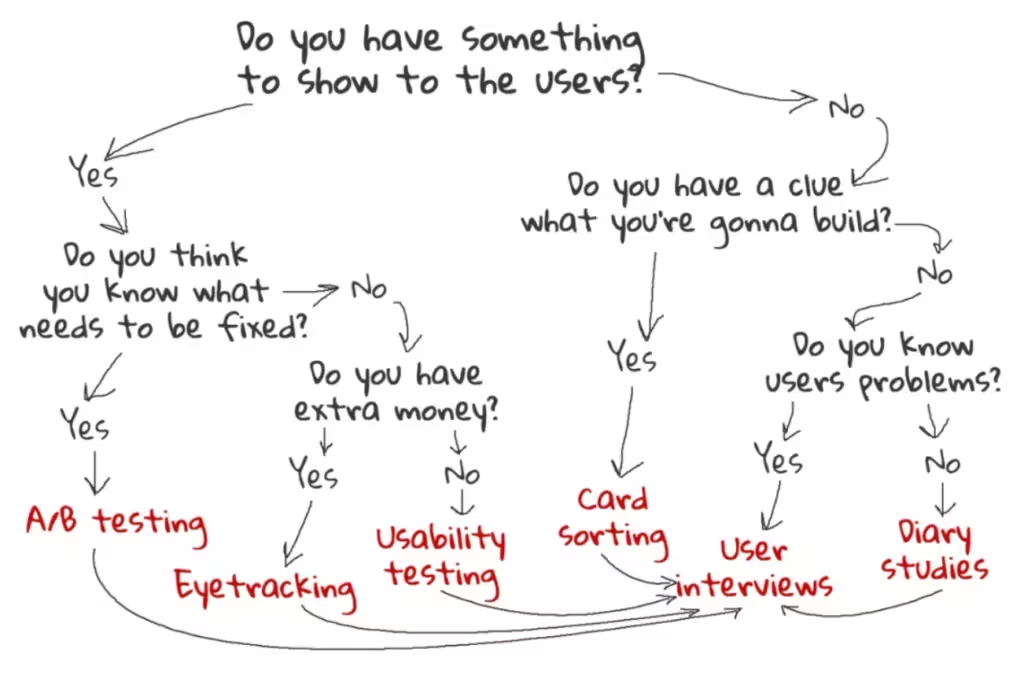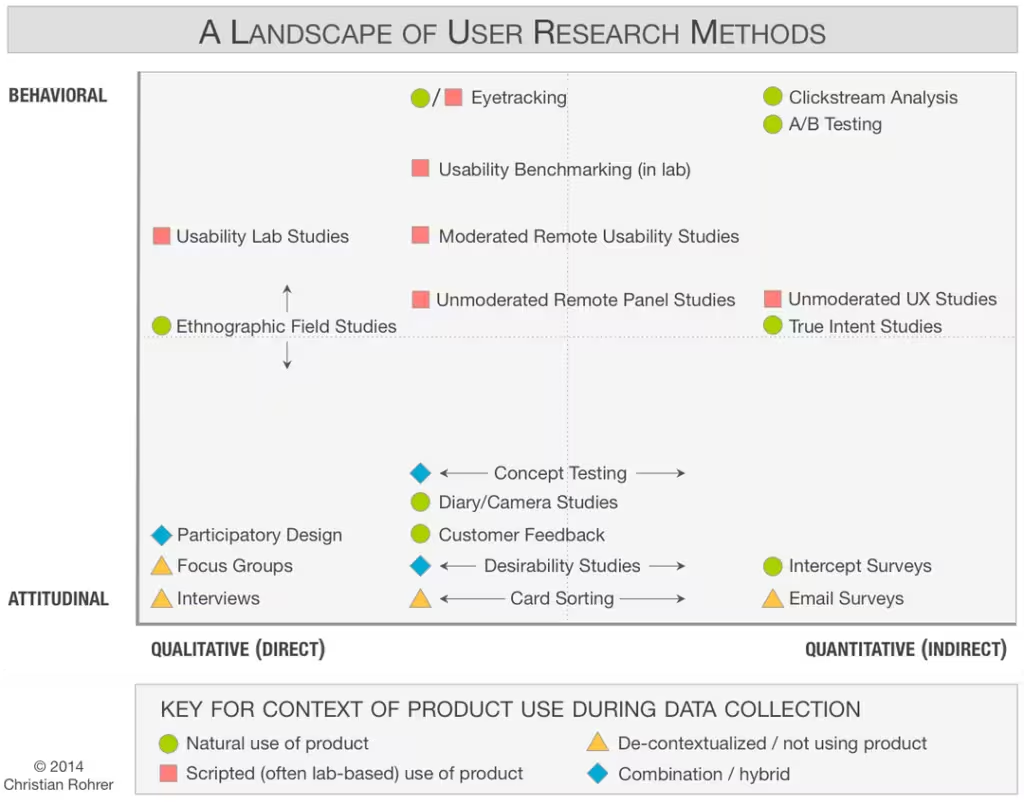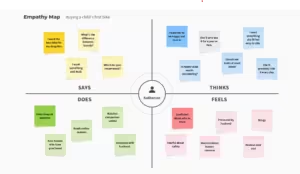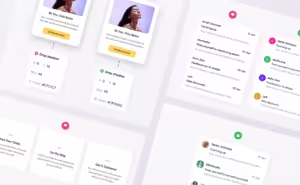Use this step-by-step guide to start your UX research journey. Discover essential techniques and best practices to understand user needs and enhance your design.

Defining the Problem
Before starting any UX research methods, it’s crucial to define the problem or goal you want to address. Clearly outlining the issue upfront ensures that the data you collect is relevant to your questions and prevents you from pursuing research that won’t provide valuable insights for your project.
This step also helps align stakeholders on what success looks like and sets clear expectations for the research outcomes.
Choosing a User Research Method
Once you’ve defined your research goals, it’s time to gather information about potential users and their needs related to your product or service.
User research can take various forms, including surveys or interviews with users and stakeholders, reviews of existing data sources like market reports, competitor analysis, and findings from other research. This foundational stage sets the groundwork for a deeper exploration of user behavior and motivations later in the process.

It’s essential to employ a mix of qualitative and quantitative methods to address all potential gaps in your research. Choosing the right methodologies and resources should depend on your users’ specific needs and business goals. Incorporating both behavioral and attitudinal UX research methods ensures you derive maximum value.
Understanding user actions, thought processes, and emotions is vital in behavioral research. Tools like heatmaps, A/B testing, eye-tracking, and recordings provide valuable insights into user behavior. Attitudinal research goes further by exploring the feelings behind user actions through surveys, interviews, focus groups, concept tests, and card sorting, offering a comprehensive view of user behaviors.
Strive to gather both qualitative and quantitative UX data for a well-rounded perspective. Quantitative studies allow you to observe user behavior through numbers—measuring how many users scroll past your CTA or click in confusion when they can’t find a button.
These metrics help identify patterns related to click-through rates, conversions, engagement, and retention. Meanwhile, qualitative data dives deeper into what drives these trends, revealing insights into customer needs and perceptions of their experiences with your website or product.
Gathering Information
After defining your research questions and selecting user research methods, the next step is to enter the discovery phase. This stage focuses on engaging with your customers to uncover what they need to convert. Aim to gain a deep understanding of their needs, challenges, and the factors that will help them achieve their goals.
Navigating the initial ambiguity of a project becomes manageable by embracing this discovery phase. Conduct thorough research and qualitative interviews to gather data about your app’s target market, users, and other relevant details. This approach equips you with the insights necessary to empower your development process and drive informed decisions.

To accurately understand users’ needs and expectations, it’s crucial to assess the customer service experience thoroughly. Regularly engage with sales, support, and training teams to discuss common customer concerns. Additionally, listening in on calls between staff and clients can help identify vocabulary differences and communication gaps.
Finally, conduct a competitive analysis of rival products. Compare features across different companies to see what resonates best with consumers, helping you avoid potential pitfalls in your own offerings.
Analyzing Data & Drawing Conclusions
Now that you’ve gathered information from interviews about users’ experiences with a product or service, it’s time to analyze this data to determine how to improve the user experience based on your research findings.
In this analysis phase, qualitative methods like card sorting can help identify common patterns in user behavior based on their feedback. Use insights from your initial discovery phase as a foundation for this process.
Next, focus on addressing your UX research questions and gain a deeper understanding of users. Develop customer journeys, user personas, and narratives to clarify the data and effectively communicate your findings. Utilize these insights to inform concept development and create design sketches, wireframes, or prototypes.

Testing
To ensure your website is as user-friendly and efficient as possible, start with usability testing. Conduct A/B or multivariate tests to determine which designs resonate most with users, and use heatmaps to track scrolling and clicking behavior.
This approach helps establish a clear hierarchy for a smoother user flow, making navigation easier than ever. Analyze which webpage elements attract customer interaction and which are overlooked.
Focus on session recordings, especially those showing rage clicks, to identify areas where users are clicking in frustration, expecting a button or action. Pay attention to dissatisfied users or those who haven’t completed key conversion tasks, and carefully examine their journey to uncover insights for improvement.
Presenting Findings
After collecting and analyzing data, it’s important to present your UX research findings clearly, ensuring stakeholders understand how various aspects of design integrate into a cohesive whole.
At this stage, make recommendations outlining the necessary changes for new designs to enhance user experiences. Your UX research data is a valuable resource that can inform decisions and improve user satisfaction, engagement, and retention. However, the true value lies in acting on these insights to address significant issues and better meet user needs.
Focus on metrics that impact user goals and leverage this UX evidence to enhance all facets of your product development.
Collecting Feedback
Before launching your new experience publicly, collaborate with various teams to determine the best ways to measure user experience and success. Schedule a review session with your development team to ensure the design has been implemented correctly, setting the stage for a successful launch.
To optimize outcomes, work with different teams to identify what should be tagged in the UI for effective data collection and success metrics. After releasing new features or experiences, take time to analyze how customers interact with them. Conduct user calls for additional insights, which can inform adjustments for the next version of your design.

Don’t focus too heavily on the opinions of a few individuals. Make sure to conduct at least three concept tests before finalizing your mock-up decisions. Once all tests are complete, adjust your design based on the feedback—whether that means making significant changes or maintaining the current direction.
These revised designs can then be used for further concept testing or moved on to usability testing. Before starting usability tests, determine the necessary complexity for these evaluations.
Conclusion
The UX research process outlined here serves as a roadmap for businesses seeking to understand how customers interact with their products or services. It also provides valuable insights for enhancing those offerings through thoughtful design.
By taking the time to understand customer needs at every stage of the UX research process, businesses can gather meaningful feedback and quantitative data. This information enables them to make informed decisions that improve customer satisfaction and overall user experience.




